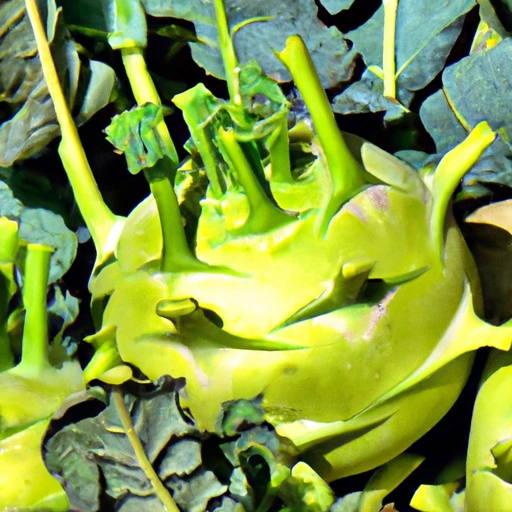Kohlrabi
Description

Kohlrabi, also known as German turnip, is a round, tuberous vegetable that is part of the cabbage family. It is typically pale green or purple and has a texture and taste that is similar to a broccoli stem or cabbage heart but is milder and sweeter. Kohlrabi can be eaten raw or cooked and offers a crunchy texture and a slight peppery flavor that complements a variety of dishes.
Common uses
Kohlrabi is commonly used as a fresh crunch in salads, as a roasted side dish, or as a hearty addition to soups and stews. It can also be grated or spiralized for use in slaws or as a healthy noodle alternative.
Nutritional value
Calories
One cup (135 grams or 4.8 ounces) of raw kohlrabi contains approximately 36 calories.
Protein
This serving size provides about 2 grams of protein, making it a low-protein vegetable.
Fat
Kohlrabi is virtually fat-free, with less than 0.1 grams of fat per serving.
Carbohydrates
It contains about 8 grams of carbohydrates, of which 5 grams are dietary fiber.
Vitamins
Kohlrabi is rich in vitamin C, providing 140% of the recommended daily value (DV) per cup, and also contains vitamin B6, folate, and thiamin.
Minerals
The vegetable is a good source of potassium, with 472 milligrams per serving, and also provides calcium, iron, and magnesium.
Health benefits
Kohlrabi is high in fiber and vitamin C, both of which are important for a healthy immune system. Its rich nutrient profile supports heart health, aids in digestion, and may contribute to weight loss as part of a balanced diet.
Potential risks
For individuals with thyroid issues, it is important to note that kohlrabi is a cruciferous vegetable and contains goitrogens, which can interfere with thyroid hormone synthesis if consumed in large quantities.
Common recipes
Kohlrabi is often featured in recipes such as creamy kohlrabi soup, kohlrabi slaw, roasted kohlrabi with parmesan, or stir-fried kohlrabi with vegetables and meats.
Cooking methods
It can be steamed, boiled, roasted, sautéed, or eaten raw. Peeling is optional as the skin is edible after being thoroughly washed.
Pairing with other ingredients
Kohlrabi pairs well with apple, carrot, herbs like thyme and rosemary, cheeses such as goat cheese and cheddar, and vinaigrettes or creamy dressings.
Summary
Kohlrabi is a versatile vegetable that is gaining popularity around the world due to its unique flavor, texture, and nutritional benefits. It can be used in a variety of culinary applications, from raw dishes to cooked meals, and offers an excellent source of vitamins and minerals.